Cymbella neocistula
-
Category
-
Length Range32-85 µm
-
Width Range11-22 µm
-
Striae in 10 µm7-10 at valve center, 10-13 near ends
-
Reported AsCymbella cistula (Patrick and Reimer 1966)
-
ContributorCarrie White - Jun 2011
-
ReviewerMarina Potapova - Feb 2013
Identification
Description
Valves strongly dorsiventral. The dorsal margin is convex and the ventral margin is linear to slightly curved and tumid at mid-valve. The valve ends are rounded, but not protracted or capitate. Striae are slightly radiate, distinctly punctate, with 16-22 areolae in 10 µm. The axial area is narrow, expanding slightly into a small round central area at mid valve. The raphe is centrally located within the axial area. The raphe is reverse lateral; the proximal raphe ends are bent ventrally and slightly expanded. Stigmata are present present on the ventral side of the central area. The number of stigmata is commonly 3-5, but occasionally only 2 stigmata are present. In some specimens, 1-2 stigmata or stigmata-like structures may be present on the dorsal side of the central area, particularly in initial cells.
Cymbella cistula was separated into three new taxa by Krammer (2002, p. 89-91). Krammer investigated 66 populations of C. cistula and morphologically similar diatoms and separated them into three taxa that could be readily distinguished from one another by number of stigmata, areola density, and overall valve outline: C. subcistula, C. neocistula, and C. dorsenotata.
Autecology
Cymbella neocistula is often found growing as an epiphyte and is attached via a mucilaginous stalk secreted from one of the apical porefields.
-
Size Range, µm3
-
Motility
-
Attachment
-
Habitat
-
Waterbody
-
Distribution
- Learn more about this
Original Description
Valves doriventrales, cymbiformes, margine dorsali magis convexa, margine ventrali leviter concave vel plus minusve recta cum levi inflation in medio, apicibus non protractis et late rotundatis, 34-110 µm longae, 12-19 µm latae. Area axialis angusta, area centralis orbicularis, circiter ½-1/4 latitudinis valvae. Raphe modice lateralis, ad aream centralem modice reverso-lateralis ad apices sensim filiformis. Latere ventrali cum 3-5 stigmata. Striae transapicales modice radiatae, distincte punctatae, 7-9 in 10 µm, ad apices 12 in µm, punctae 17-20 (22) in 10 µm. A C. cymbiformis satis differ. Typus: Germania occidentalis, Eifel, lacus Holzmaar, 4.4.1977, praep. 255 IOK
-
AuthorKrammer 2002
-
Length Range34-110 µm
-
Width12-19 µm
-
Striae in 10µm7-9 in the center of valve, becoming 12 at the ends, punctae 17-20(22)
Citations & Links
Citations
Links
-
Index Nominum Algarum
Cite This Page
White, C. (2011). Cymbella neocistula. In Diatoms of North America. Retrieved April 20, 2024, from https://diatoms.org/species/cymbella_neocistula
Responses
The 15 response plots show an environmental variable (x axis) against the relative abundance (y axis) of Cymbella neocistula from all the stream reaches where it was present. Note that the relative abundance scale is the same on each plot. Explanation of each environmental variable and units are as follows:
ELEVATION = stream reach elevation (meters)
STRAHLER = distribution plot of the Strahler Stream Order
SLOPE = stream reach gradient (degrees)
W1_HALL = an index that is a measure of streamside (riparian) human activity that ranges from 0 - 10, with a value of 0 indicating of minimal disturbance to a value of 10 indicating severe disturbance.
PHSTVL = pH measured in a sealed syringe sample (pH units)
log_COND = log concentration of specific conductivity (µS/cm)
log_PTL = log concentration of total phosphorus (µg/L)
log_NO3 = log concentration of nitrate (µeq/L)
log_DOC = log concentration of dissolved organic carbon (mg/L)
log_SIO2 = log concentration of silicon (mg/L)
log_NA = log concentration of sodium (µeq/L)
log_HCO3 = log concentration of the bicarbonate ion (µeq/L)
EMBED = percent of the stream substrate that is embedded by sand and fine sediment
log_TURBIDITY = log of turbidity, a measure of cloudiness of water, in nephelometric turbidity units (NTU).
DISTOT = an index of total human disturbance in the watershed that ranges from 1 - 100, with a value of 0 indicating of minimal disturbance to a value of 100 indicating severe disturbance.

Cymbella neocistula
- Striae distinctly punctate
- Ventral stigmata 3-5
- Raphe complex
- Areolae 16-22 in 10 µm
Striae distinctly punctate, slightly radiate. Usually 3-5 stigmata are present (occasionally 2), each located at the end of a ventral stria in the central area. The central area is small and round. The raphe is reverse lateral. Areolae number 16-22 in 10 µm.
 Diatoms of North America
Diatoms of North America







